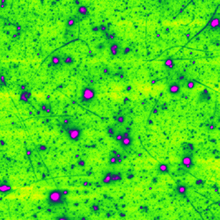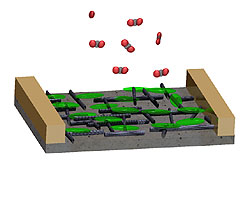Home > Press > Monitoring Life, One Breath at a Time
Abstract:
A tiny device that can monitor a victim's breathing in emergency situations
Monitoring Life, One Breath at a Time
Respiratory sensor may provide new tool for emergency responders
Arlington, VA – November 10, 2004
Researchers have created a tiny device that can monitor a victim's breathing in emergency situations by effectively shrinking an operating room machine into a small, disposable tool that can be carried to a disaster site.
NSF-supported researchers at Nanomix, Inc., in Emeryville, Calif., have created a transistor that fuses carbon nanotubes, polymers and silicon into a capnography sensor -- a human breathing monitor.
Alexander Star and his colleagues at Nanomix and the University of California, Los Angeles, describe the new sensor in the cover article of the November 15 issue of the journal Advanced Materials. Their study shows that carbon nanotube transistors fused with carbon dioxide-detecting polymers can determine carbon dioxide (CO2) concentrations in both ambient and exhaled air.
Capnography sensors detect subtle changes in the concentration of carbon dioxide gas in a person’s breath, revealing respiratory diseases in children and adults, and allowing anesthesiologists to monitor a patient’s breathing during surgery.
In the field, emergency responders may be able to use the new sensor to verify proper breathing tube placement, monitor the patient's respiratory patterns and assess the effect of life support measures.
While the Nanomix device is already capable of monitoring human breathing in laboratory settings, the researchers are collaborating with anesthesiologists and other specialists at the University of California, San Francisco, to design and test a field-ready medical device.
The Nanomix researchers developed their nanotube transistor as part of NSF's Small Business Innovation Research program, and they are also applying the new technology to optoelectronic memory applications.
The same electronic interactions between polymers and carbon nanotubes that sense CO2 can also yield photo-sensitive devices that record the binary "on" and "off" patterns of digital memory. The memory is written optically, but read and erased electronically.
When researchers shine light on the polymer-coated nanotube transistors, electric signals are stored as charges in the nanotubes. Because different polymers absorb light differently, engineers can tune the device to work under specific light waves. By changing the voltage in the device, one can control the read and erase functions.
These research results, which were published in the September issue of Nano Letters, differ from other memory and optical applications of nanotube transistors.
Comments from the researchers:
"We have developed nanoelectronic sensors that accurately measure carbon dioxide in human breath. This sensing technology will break new ground in the development of medical devices that take advantage of the unique qualities of nanotechnology – small size, low power and high sensitivity." -- Alexander Star, Manager, Applications Development, Nanomix, Inc.
"We are using two-layer nanodevice assembly, which allows us to control each component to change the operation of the devices. While the nanotube layer defines the density and complexity of nanodevice arrays on the chip, we can independently fine-tune the devices by using different polymers." -- Alexander Star
Comments from UCSF:
"Being able to continuously and accurately measure carbon dioxide in exhaled breath with a small, inexpensive and pre-calibrated device is a very significant development in clinical care. It will improve emergency care in the field by helping guide resuscitation efforts and also provide important feedback about adequacy of ventilation. " -- Philip E. Bickler, Department of Anesthesia and Perioperative Care, University of California, San Francisco
Comments from NSF:
"The potential impact of this device is huge. This technology could lead to a low-cost, small-size, low-power carbon dioxide sensor. The high-sensitivity device might replace bulky and expensive NDIR (non-dispersive infrared absorption) sensors." -- Winslow Sargeant, NSF Small Business Innovation Research Program officer who oversees the Nanomix award.
"This is a high-risk, high-return technology. On a larger scale, the finalized product would lower the cost of respiratory track monitoring, becoming an essential tool for intensive care units and during anesthesia." -- Winslow Sargeant
For more information on this research, see: link.
Principal Investigator:
Alexander Star
Nanomix, Inc
(510) 428-5323
AStar@nano.com
Co-Investigator:
Philip E. Bickler
University of California, San Francisco
(415) 476-1411
bicklerp@anesthesia.ucsf.edu
The National Science Foundation (NSF) is an independent federal agency that supports fundamental research and education across all fields of science and engineering, with an annual budget of nearly $5.58 billion. NSF funds reach all 50 states through grants to nearly 2,000 universities and institutions. Each year, NSF receives about 40,000 competitive requests for funding, and makes about 11,000 new funding awards. The NSF also awards over $200 million in professional and service contracts yearly.
Media contact:
Josh Chamot, NSF
(703) 292-7730
jchamot@nsf.gov
Program contact:
Winslow Sargeant, NSF
(703) 292-7313
wsargean@nsf.gov
Copyright © NSF
If you have a comment, please us.
Issuers of news releases, not 7th Wave, Inc. or Nanotechnology Now, are solely responsible for the accuracy of the content.
| Related Links |
![]() University of California, San Francisco
University of California, San Francisco
| Related News Press |
Possible Futures
![]() Discovery points path to flash-like memory for storing qubits: Rice find could hasten development of nonvolatile quantum memory April 5th, 2024
Discovery points path to flash-like memory for storing qubits: Rice find could hasten development of nonvolatile quantum memory April 5th, 2024
![]() With VECSELs towards the quantum internet Fraunhofer: IAF achieves record output power with VECSEL for quantum frequency converters April 5th, 2024
With VECSELs towards the quantum internet Fraunhofer: IAF achieves record output power with VECSEL for quantum frequency converters April 5th, 2024
Nanotubes/Buckyballs/Fullerenes/Nanorods/Nanostrings
![]() Tests find no free-standing nanotubes released from tire tread wear September 8th, 2023
Tests find no free-standing nanotubes released from tire tread wear September 8th, 2023
![]() Detection of bacteria and viruses with fluorescent nanotubes July 21st, 2023
Detection of bacteria and viruses with fluorescent nanotubes July 21st, 2023
Nanomedicine
![]() New micromaterial releases nanoparticles that selectively destroy cancer cells April 5th, 2024
New micromaterial releases nanoparticles that selectively destroy cancer cells April 5th, 2024
![]() Good as gold - improving infectious disease testing with gold nanoparticles April 5th, 2024
Good as gold - improving infectious disease testing with gold nanoparticles April 5th, 2024
![]() Researchers develop artificial building blocks of life March 8th, 2024
Researchers develop artificial building blocks of life March 8th, 2024
Sensors
Announcements
![]() NRL charters Navy’s quantum inertial navigation path to reduce drift April 5th, 2024
NRL charters Navy’s quantum inertial navigation path to reduce drift April 5th, 2024
![]() Discovery points path to flash-like memory for storing qubits: Rice find could hasten development of nonvolatile quantum memory April 5th, 2024
Discovery points path to flash-like memory for storing qubits: Rice find could hasten development of nonvolatile quantum memory April 5th, 2024
|
|
||
|
|
||
| The latest news from around the world, FREE | ||
|
|
||
|
|
||
| Premium Products | ||
|
|
||
|
Only the news you want to read!
Learn More |
||
|
|
||
|
Full-service, expert consulting
Learn More |
||
|
|
||










